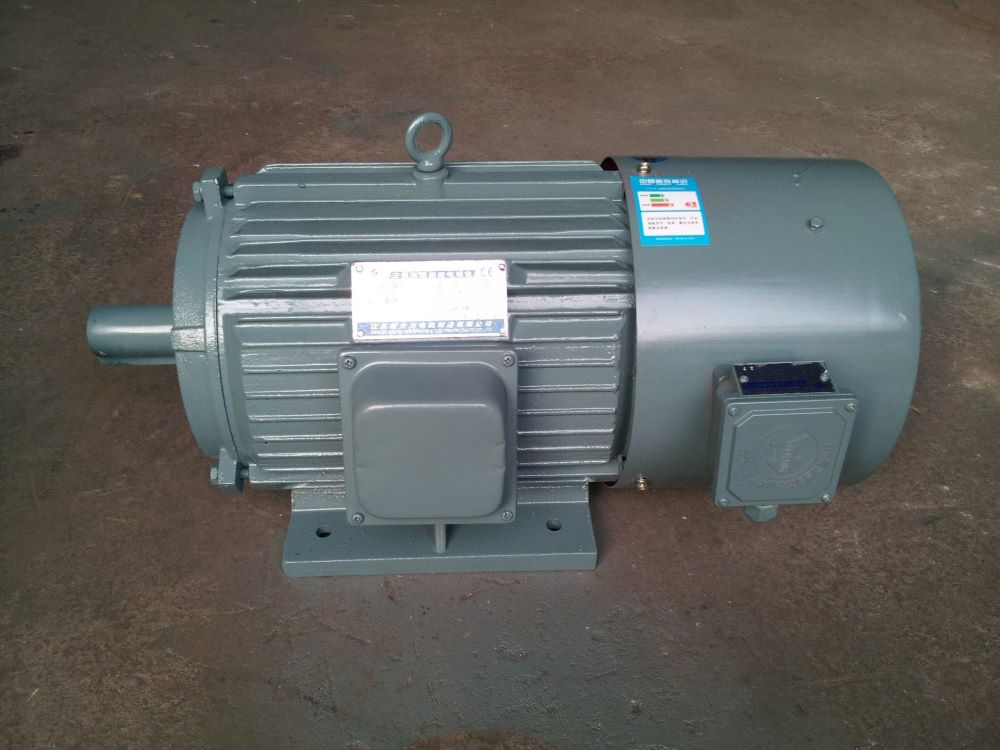Bagaimanakah motor kelajuan berubah-ubah berfungsi?
A motor elektrik kelajuan berubah-ubah ialah motor elektrik yang boleh beroperasi pada pelbagai kelajuan, bukannya kelajuan tetap seperti motor elektrik tradisional. Terdapat beberapa jenis motor elektrik kelajuan berubah-ubah, termasuk motor aruhan AC, Motor DC, motor DC tanpa berus, dan motor segerak. Kaedah khusus di mana motor elektrik kelajuan berubah-ubah berfungsi bergantung pada jenis motor.

Motor aruhan AC: Bagaimanakah motor kelajuan berubah-ubah berfungsi?
Motor aruhan AC adalah jenis kelajuan berubah-ubah yang paling biasa motor elektrik dan digunakan dalam pelbagai aplikasi. Mereka bekerja dengan menggunakan arus ulang alik (AC) untuk menghasilkan medan magnet berputar yang memacu motor. Kelajuan motor aruhan AC boleh dikawal dengan menukar frekuensi voltan AC yang digunakan padanya.
Motor aruhan AC terdiri daripada pemegun (bahagian motor yang pegun) dan pemutar (bahagian motor yang berputar). Stator biasanya terdiri daripada satu siri gegelung dawai yang dililit di sekeliling teras, manakala pemutar biasanya terdiri daripada satu siri magnet kekal.
Apabila voltan AC dikenakan pada pemegun, ia mewujudkan medan magnet berputar. Medan magnet ini berinteraksi dengan medan magnet rotor, menyebabkan pemutar berputar selari dengan medan magnet stator. Kelajuan pemutar adalah berkadar terus dengan kekerapan voltan AC yang digunakan pada pemegun.
Dengan menukar kekerapan voltan AC yang digunakan pada pemegun, kelajuan rotor boleh dikawal. Ini biasanya dilakukan menggunakan pemacu frekuensi berubah-ubah (VFD), yang merupakan peranti yang melaraskan kekerapan voltan AC yang digunakan pada motor. VFD biasanya digunakan untuk mengawal kelajuan motor aruhan AC.
Motor DC: Bagaimanakah motor kelajuan berubah-ubah berfungsi?
Motor DC menggunakan arus terus (DC) untuk menghasilkan medan magnet berputar, dan kelajuan motor boleh dikawal dengan melaraskan voltan yang dikenakan pada motor. Motor DC biasanya digunakan dalam aplikasi yang memerlukan kawalan kelajuan yang tepat, seperti dalam kenderaan elektrik dan robotik.
Motor DC terdiri daripada pemegun (bahagian motor yang pegun) dan pemutar (bahagian motor yang berputar). Stator biasanya terdiri daripada satu siri gegelung dawai yang dililit di sekeliling teras, manakala pemutar biasanya terdiri daripada satu siri magnet kekal.
Apabila voltan DC dikenakan pada pemegun, ia mewujudkan medan magnet berputar. Medan magnet ini berinteraksi dengan medan magnet rotor, menyebabkan pemutar berputar selari dengan medan magnet stator. Kelajuan pemutar adalah berkadar terus dengan voltan yang dikenakan pada pemegun.
Dengan menukar voltan yang digunakan pada stator, kelajuan rotor boleh dikawal. Ini biasanya dilakukan menggunakan pemacu DC, iaitu peranti yang melaraskan voltan yang dikenakan pada motor. Pemacu DC biasanya digunakan untuk mengawal kelajuan motor DC.
Motor DC tanpa berus: Bagaimanakah motor kelajuan berubah-ubah berfungsi?
Kelajuan berubah-ubah motor DC tanpa berus (BLDC) ialah sejenis motor elektrik yang menggunakan arus terus (DC) bekalan kuasa untuk menjana pergerakan putaran. Tidak seperti tradisional motor DC berus, yang menggunakan berus mekanikal untuk memindahkan arus elektrik ke rotor, motor DC tanpa berus menggunakan pertukaran elektronik untuk mengawal aliran arus ke pemutar. Ini membolehkan motor yang lebih cekap dan boleh dipercayai, kerana tiada berus mekanikal haus atau menyebabkan arka elektrik.
Untuk mengawal kelajuan motor DC tanpa berus, pemacu frekuensi berubah-ubah (VFD) biasanya digunakan. VFD ialah peranti elektronik yang mengawal kelajuan motor elektrik dengan mengubah frekuensi kuasa elektrik yang dibekalkan kepada motor.. Dengan menukar frekuensi kuasa elektrik, VFD boleh mengawal kelajuan motor dengan menukar bilangan kali rotor motor berputar sesaat.
Untuk mengawal kelajuan motor DC tanpa berus menggunakan VFD, VFD terlebih dahulu menukarkan arus ulang alik yang masuk (AC) kuasa kepada arus terus (DC) kuasa menggunakan penerus. Kuasa DC kemudian dimasukkan ke dalam penyongsang, yang menukarkannya semula kepada kuasa AC pada frekuensi yang berbeza. Kuasa AC kemudiannya dibekalkan kepada motor, menyebabkan ia berputar pada kelajuan yang ditentukan oleh kekerapan kuasa.
Selain mengawal kelajuan motor, VFD juga bertanggungjawab untuk mengawal arah putaran motor. Dengan membalikkan kekutuban kuasa elektrik yang dibekalkan kepada motor, VFD boleh menyebabkan motor berputar ke arah yang bertentangan.
Keseluruhannya, Motor DC tanpa berus kelajuan berubah-ubah adalah alat penting untuk pelbagai aplikasi, termasuk sistem HVAC, pam, peminat, dan tali pinggang penghantar. Dengan membenarkan kawalan tepat ke atas kelajuan motor, Motor DC tanpa berus boleh ubah kelajuan boleh membantu meningkatkan kecekapan, mengurangkan penggunaan tenaga, dan meningkatkan prestasi keseluruhan sistem.

Motor segerak: Bagaimanakah motor kelajuan berubah-ubah berfungsi?
Motor segerak kelajuan berubah ialah sejenis motor elektrik yang beroperasi pada kelajuan segerak tertentu, yang ditentukan oleh kekerapan kuasa elektrik yang dibekalkan kepada motor dan bilangan kutub dalam motor. Kelajuan motor segerak boleh diubah dengan mengubah frekuensi kuasa elektrik yang dibekalkan kepada motor., sama ada melalui penggunaan pemacu frekuensi berubah-ubah (VFD) atau dengan menukar bilangan kutub dalam motor.
Satu cara untuk mengawal kelajuan motor segerak adalah melalui penggunaan pemacu frekuensi berubah-ubah (VFD). VFD ialah peranti elektronik yang mengawal kelajuan motor elektrik dengan mengubah frekuensi kuasa elektrik yang dibekalkan kepada motor.. Dengan menukar frekuensi kuasa elektrik, yang VFD boleh mengawal kelajuan motor dengan menukar bilangan kali rotor motor berputar sesaat.
Untuk mengawal kelajuan motor menggunakan VFD, VFD terlebih dahulu menukarkan arus ulang alik yang masuk (AC) kuasa kepada arus terus (DC) kuasa menggunakan penerus. Kuasa DC kemudian dimasukkan ke dalam penyongsang, yang menukarkannya semula kepada kuasa AC pada frekuensi yang berbeza. Kuasa AC kemudiannya dibekalkan kepada motor, menyebabkan ia berputar pada kelajuan yang ditentukan oleh kekerapan kuasa.
Satu lagi cara untuk mengawal kelajuan motor segerak ialah dengan menukar bilangan kutub dalam motor. Bilangan kutub dalam motor merujuk kepada bilangan pasangan medan magnet di sekeliling stator motor. Semakin banyak bilangan tiang, semakin perlahan motor akan berputar pada frekuensi tertentu. Dengan menukar bilangan tiang dalam motor, kelajuan di mana motor berputar boleh dikawal.
Keseluruhannya, motor segerak kelajuan berubah-ubah berguna untuk aplikasi di mana kawalan yang tepat melebihi kelajuan motor diperlukan, seperti dalam sistem HVAC, pam, peminat, dan tali pinggang penghantar. Dengan membenarkan kawalan tepat ke atas kelajuan motor, motor segerak kelajuan berubah-ubah boleh membantu meningkatkan kecekapan, mengurangkan penggunaan tenaga, dan meningkatkan prestasi keseluruhan sistem.



